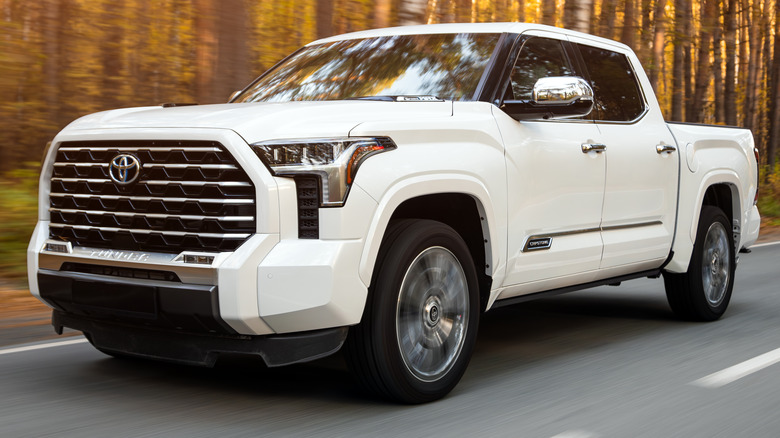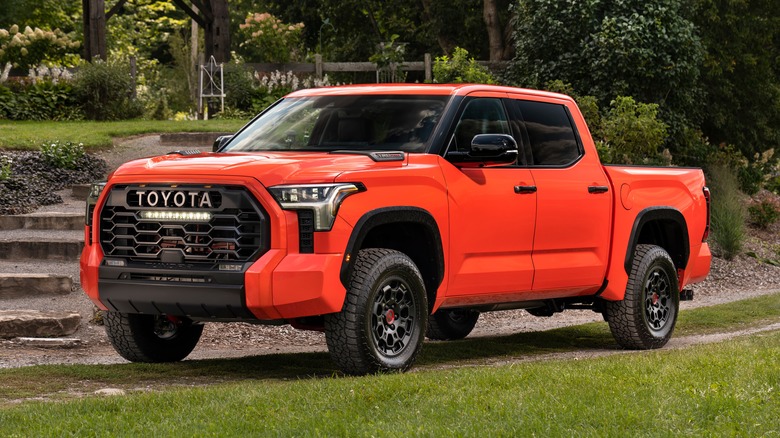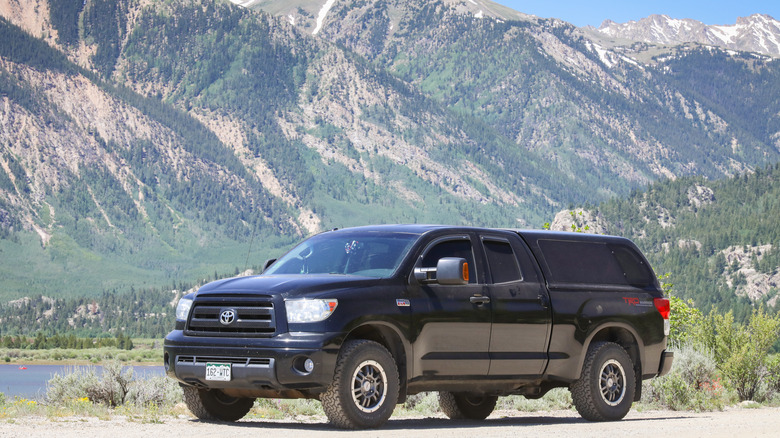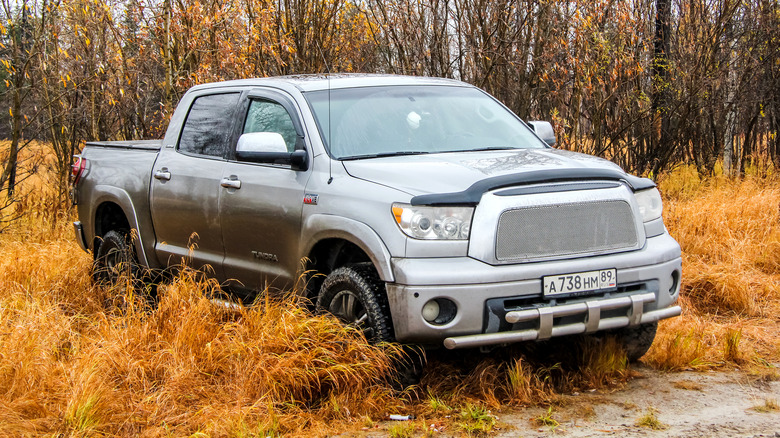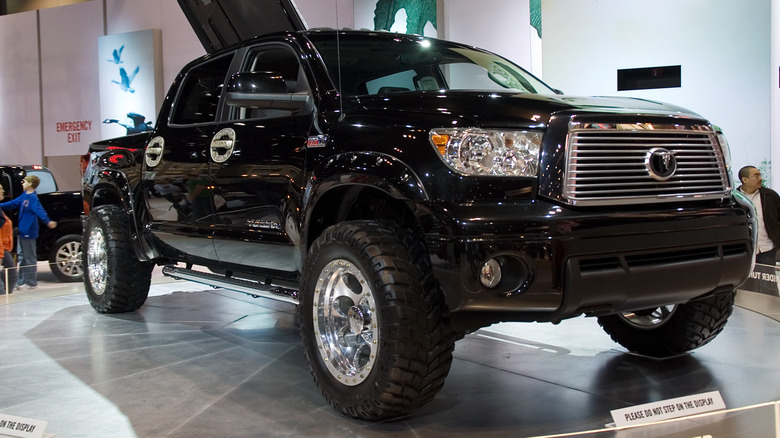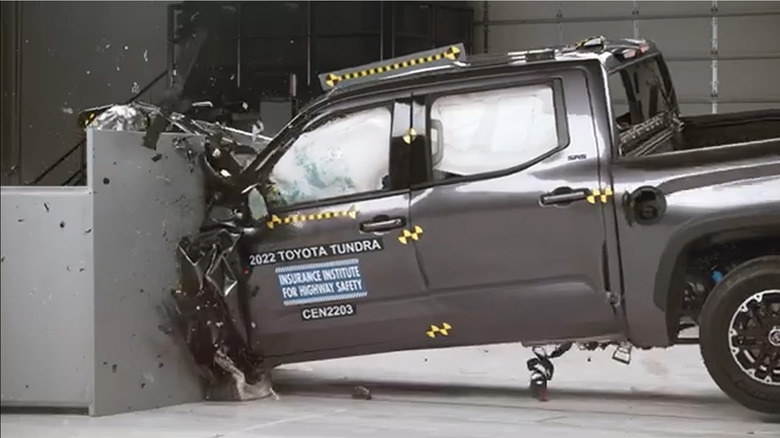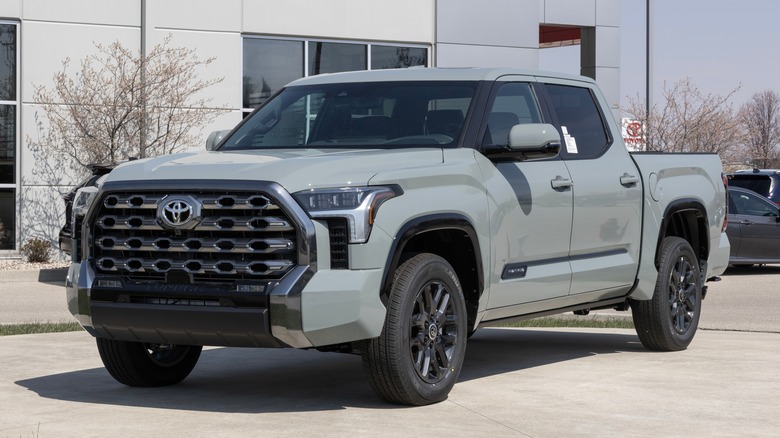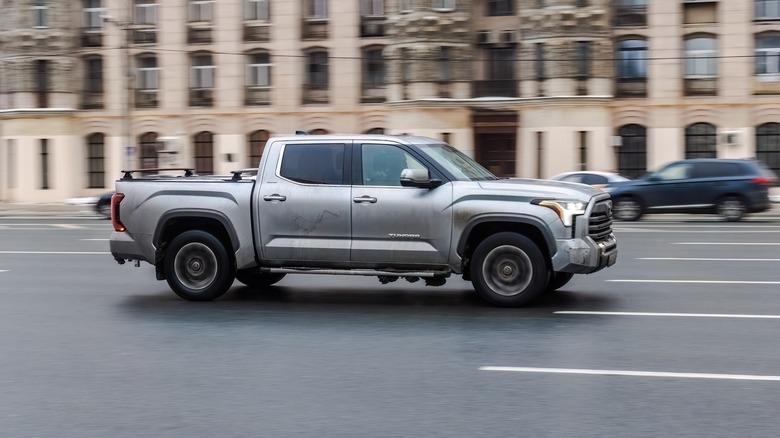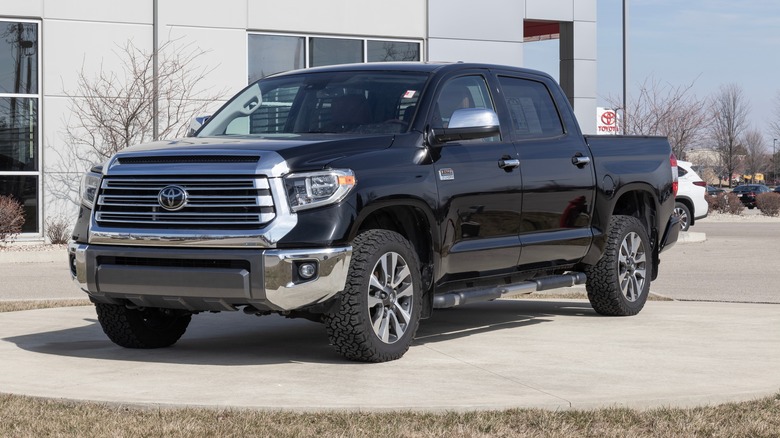8 Reasons To Consider A Used Toyota Tundra For Your Next Truck
The Toyota Tundra doesn't have the long history of some other full-size trucks. When it started life as the T100 in 1992 it was a rousing failure in the U.S. The T100 was underpowered, more expensive, and smaller than the V8-powered trucks being pumped out by U.S. automakers back then. Years later in 1998, Toyota introduced the T150, which was immediately set upon by Ford for being very similar to the F-150 in terms of naming conventions. After some legal back and forth, Toyota agreed to remove the T150 name and the Tundra was officially born in 1999.
Toyota first assembled the truck at its Toyota Motor Manufacturing plant in Indiana before moving production to its Texas plant in 2008. So, while the truck has a Japanese nameplate, it's assembled in the same country where Toyota hopes to sell the highest number of them. They generally compete favorably against their American-made counterparts, and you may be considering buying one as your next truck.
Depending on whether you get one new or used, tow ratings for these trucks can reach as high as 12,000 pounds as of the 2023 model year. That's in the same neighborhood as the insanely popular Ford F-150, so you're not missing too much if you go with one over the other. With plenty of drivetrain options over the years, you could do much worse in terms of truck choices. Here are several other reasons why a used Tundra may be right for you.
They are generally reliable
The Toyota Tundra is a generally dependable truck. That's true of many Toyota vehicles, so it's no surprise that the Tundra shares the brand's strong reliability ratings. That translates to many years on the open road without too many issues and owners who can look forward to not fixing something every few years. Reliability numbers get a little harder to find for the oldest models, but given the long history of positive press about the Tundra's reliability, you'll have pretty good odds of getting a working truck regardless of which year you go for.
J.D. Power ranks the truck as average or above average for its reliability rating depending on which year you go for. Consumer Reports notes that the 2007 through 2021 models being reliable is one of the biggest advantages to buying one over a used model from an American-made competitor. Newer models have been subject to some recalls due to a turbo engine manufacturing issue, but Toyota says that those issues have been sorted either through manufacturing improvements or through the recall.
RepairPal rates the Tundra at sixth out of 17 for its reliability rating for full-size trucks. The site says that repairs tend to be more severe than average but occur less frequently than what is normal, so the total annual repair costs for the Tundra are about average for the class. So, if you buy yourself a Tundra, it likely won't break down very often — it just might be a tad costly if it does.
TRD models have legitimate off-roading chops
Toyota is well known for its TRD trims on its various vehicles. For trucks, that generally means a few things. Tundra TRDs get upgraded suspensions designed for off-roading. The brand depends on the year, but modern Tundras get Bilstein shocks or FOX off-road shocks. The alloy wheels are wrapped with Wildpeak all-terrain tires as well with an optional upgrade to 20-inch wheels wrapped in the same tire. TRD Tundras also come with an LED light bar, an aluminum skid plate, and more. Features vary depending on the year but most TRD Toyotas have some special features to make it off-road capable.
The upgraded shocks do make the truck drive a little rough on pavement, so it's something to keep in mind. Modern Tundras are also equipped with downhill assist, crawl control, a multi-terrain monitor that uses cameras at ground level to let you see obstacles, and a locking rear differential to help you drive off-road. While competitors have also put together pretty good options in this space, like Ford F-150 Raptor, the Tundra isn't falling behind in the onboard technology department.
Of course, there are some downsides to opting for the off-road TRD trim of the Tundra. For example, the softer spring rates of the off-road focused suspension does make the truck a little awkward for towing since it'll cause the truck to squat. It can still tow, but it'll look a little lower than a regular Tundra will. In any case, reviewers agree that the TRD version of the Tundra is very capable of off-roading and does so as good or, in some cases, better than most competitors.
It has excellent resale value
Like many Toyota vehicles, the Toyota Tundra holds its value extremely well. In fact, the Tundra specifically has won a few different awards for its excellent resale value. In 2023, the Kelley Blue Book named the Toyota Tundra the vehicle with the best resale value. It's worth noting that this ranking was taken from all available consumers vehicles and not just trucks, as a 2023 Toyota Tundra is estimated to keep 73.3% of its value after five years. That is higher than cars from other manufacturers like the Tesla Model X, the Ford Bronco, the Chevy Corvette, the Honda Civic, and the Subaru Crosstrek — all of whom made KBB's top ten list.
KBB's valuation is matched by other websites. For example, Car Edge estimates that the 2023 Tundra will keep 72.27% of its resale value after five years and 49.6% of its value after a decade. The Ford F-150 and RAM 1500 retain similar value for the first five years, but after a decade, the Ford F-150 is estimated to keep only 44.59% of its value and the RAM does even worse with 40.23% of its value. In short, if you want to be able to sell your truck for its maximum value after 10 years, you may want to consider buying a Tundra.
Even among Toyotas, the Tundra does pretty well. It stands to hold its value better than other mainstay Toyota vehicles like the Tacoma, 4Runner, and the Camry. It is the top dog in Toyota's lineup when it comes to resale value and there's no doubt about it. That means even when you buy used, you'll be able to sell the truck used later for more than most other competitors, assuming that it stays in good shape.
There is a healthy aftermarket community
Truck mods are a big reason to get a truck to begin with. You take what the manufacturer gives you and then add what you want to make the truck the exact one that you want. According to some estimates, over 20% of truck owners will modify their truck within the first 90 days of ownership. Fortunately for prospective Toyota Tundra owners, there are plenty of mods to choose from that range from under a couple hundred to several thousands of dollars depending on how far you want to go.
You can find a lot of the usual stuff like wheels and tires to either improve the ride or the off-road capabilities along with basic stuff like all-weather floor mats, window tinting, and things like that. However, Tundra owners can also find lift kits, engine modifications, suspension modifications, and exhaust modifications that can alter the sound, stance, and performance of the Tundra. Additionally, functional mods like winches and recovery gear can really help if you take the truck off-roading or find someone stuck in a ditch. There is also a host of aesthetic mods like replacement bumpers, lighting kits, alternate grilles, brake caliper covers, and more.
How far you want to go is based simply on preference. Some folks prefer the truck stock, but you can find tons of conversations online about mods for the Tundra across all of its years and not just newer models.
Tundras have excellent safety ratings
Toyota vehicles are some of the safest in the industry and the Tundra is no different. The 2023 Toyota Tundra won two Insurance Institute for Highway Safety (IIHS) Top Safety Pick+ awards, one for the CrewMax version of the truck and one for the Double Cab version. Both versions of the truck scored exceptionally well on IIHS' tests, which is fairly indicative of the Tundra across its lifespan since it has almost always aced those tests.
While the IIHS' tests have increased in complexity and thoroughness over the years, that has rarely phased the Tundra. The 2010 variant had nearly perfect scores across the board. When the IIHS expanded its testing in 2015, the Tundra from that year didn't do quite as well but still aced most of the tests. By 2020, Toyota had worked out most of the kinks and improved scores in almost all areas. Finally, the latest redesign in 2022 essentially fixed all of the problems, returning the Tundra to near perfect scores, where it remains as of this writing.
Newer Tundras also benefit from a swath of other safety tech as the truck got newer and newer. The 2022 model included Toyota Safety Sense 2.5, which had pedestrian detection, lane tracing assist, front and rear parking assist, and blind spot monitoring. In 2022, you had to get higher trim levels to get some of those features but they all come as standard in the 2024 models. This means that if you want the best of Toyota's safety suite, you'll want the most recent model you can afford but you don't necessarily have to buy brand new.
The hybrid Tundras return respectable fuel economy
One of the worst parts of owning a full-size truck is the fuel economy. The Tundra generally doesn't compete very well with models that offer a regular gas engine. Even newer models with all of the engine upgrades and enhancements scores fairly poorly with the 2020 Tundra 2WD variant earning 15 MPG combined while the 4WD variant combining for 14 MPG. You can at least partially solve that problem by picking up a hybrid Tundra instead of an all gas one.
Toyota introduced the hybrid version of the Tundra in 2022, so you can find them on the used market. Toyota had a reputation for slow hybrid cars once upon a time, but even the Toyota Prius looks way cooler and is way faster now than it used to be. The Tundra's hybrid system features a twin turbo V6, and the 2022 Tundra Hybrid makes a very respectable 437 horsepower along with 583 lb-ft of torque. With the right equipment, the hybrid Tundra can still tow north of 11,000 pounds, meaning you get the increased fuel economy while still having a fully capable truck.
The fuel economy isn't too much better, but it is something. The 2022 hybrid Toyota Tundra is rated at 18 MPG in the city, 23 MPG on the highway, and a combined 20 MPG, which is significantly better than the gas-only models. Drivers report getting anywhere from 14 MPG to 22 MPG, although reviewers say you can match or beat EPA estimates if you baby the truck while you drive.
Its a full-size truck for full-size jobs
Tundras are big trucks, and that means you can do a lot with them. In general, full-size trucks can tow more than midsize or smaller pickup trucks, which makes them better for heavier tasks like hauling stuff in the bed or pulling a trailer. Plus, the cabs tend to be bigger, which is nice for heavier folks or people looking to haul their family for long distances. In short, full-size trucks can do just about anything, and that's one of the reasons they're so popular.
For comparisons sake, let's look as the midsize truck in Toyota's lineup, the Tacoma. It features 39 inches of headroom, 57 inches of hip room, and 42 inches of legroom for the front passengers and 38 inches of headroom, 56 inches of hip room, and 32 inches of leg room for the rear occupants. In the Tundra, you get 41 inches of headroom up front, 62 inches of hip room, and 41 inches of legroom for the front passengers and 38.5 inches of headroom, 60.5 inches of hip room, and up to 41 inches of legroom in the backseat with the CrewMax cabin. The difference doesn't seem big — until you actually attempt to put five people in one.
As Toyota's biggest pickup truck, the Tundra should cover all of your bases regardless of what you're going for. That's the benefit of a used full-size truck over a small vehicle or even most SUVs and crossovers.
It's the most popular full-size truck not made in the U.S.
It's no secret that the big three in full-size trucks are Ford, Ram, and GM/Chevy. The American automakers put a lot of effort into marketing and selling their trucks and that's why they're so popular. However, if we were to switch that to the big four, the Toyota Tundra would be in that group. Toyota moves a lot of these trucks every year and consistently crosses the 100,000 units sold threshold. This is especially true with newer variants since Toyota did such a good job on its 2022 redesign.
Despite coming in fourth when it comes to sales figures, the Tundra community is surprisingly competitive to other truck fandoms in terms of size. The Toyota Tundra subreddit boasts 51,000 members, which is actually more than the Chevy Silverado and only a little bit less than the Ram trucks subreddit. The only one with way more is the Ford F-150 subreddit at 90,000 members . That means if you do buy a Tundra, you'll have people to talk to about it, which can be half the fun of owning a vehicle. Granted, Reddit isn't the end-all-be-all of popularity, but if you have a question, there should be someone around with an answer.
Since the aforementioned automakers are from the U.S. and Toyota is Japanese, that means the Tundra is the closest any non-US automaker has come to breaking into the top three best-selling trucks in the US. You don't get to hold that position unless your truck is good, and the Tundra is pretty great overall.
